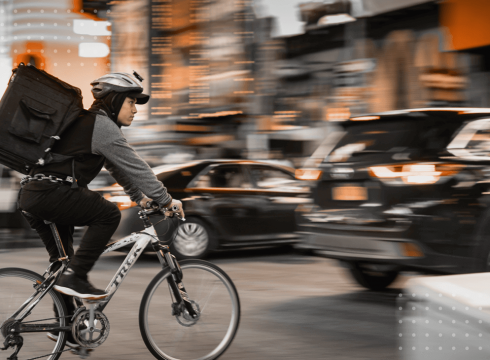How Instant Delivery Dominates E-Grocery, and How You Can Join the Game

If we need to find the favourite keywords of the 21st century, speed would probably be in the top ten. In a world where everything’s getting faster by popular demand, eCommerce was bound to get a new prefix. Welcome to the age of qCommerce, where the instant delivery model is changing the way people shop online forever.
The instant delivery market is predicted to triple its market value by 2025, from $25 billion in 2021 to $73 billion in 2025.
As a SaaS and PaaS company that offers quicker and more convenient ways to eCommerce businesses and grocers, the rapid delivery model excites us more and more each day. So in this article, we’ve decided to explain how eCommerce is getting stronger with qCommerce and how growing instant delivery business models are shaping the future of online commerce.
The Story Behind Growing Instant Delivery Businesses
Instant delivery had always been a dream for both consumers and businesses that seemed nearly impossible to turn into reality. Although some small businesses had been trying to offer instant delivery services of their own, the operations were
bound to stay local. In the early 2010s, the new chapter for grocery delivery began with small attempts, thanks to the mobile revolution.
Uber Eats, Postmates, and Instacart were three of the predecessor companies that began offering last-mile delivery on a larger scale. The businesses focused on partnering with third-party grocers to pick up and deliver to customers within an hour. But it wasn’t until the pandemic that we saw the boom in instant delivery models and countless new start-ups joining the game with their own unique styles.
The Pandemic Effect
One of the biggest catastrophes of the modern age, the COVID-19 pandemic, has transformed many things, some for the better, some for the worse. And being locked down in our houses was not good news for the grocery industry. As a result, the qCommerce boom happened, and it has become the new normal for a considerable portion of consumers quicker than expected.
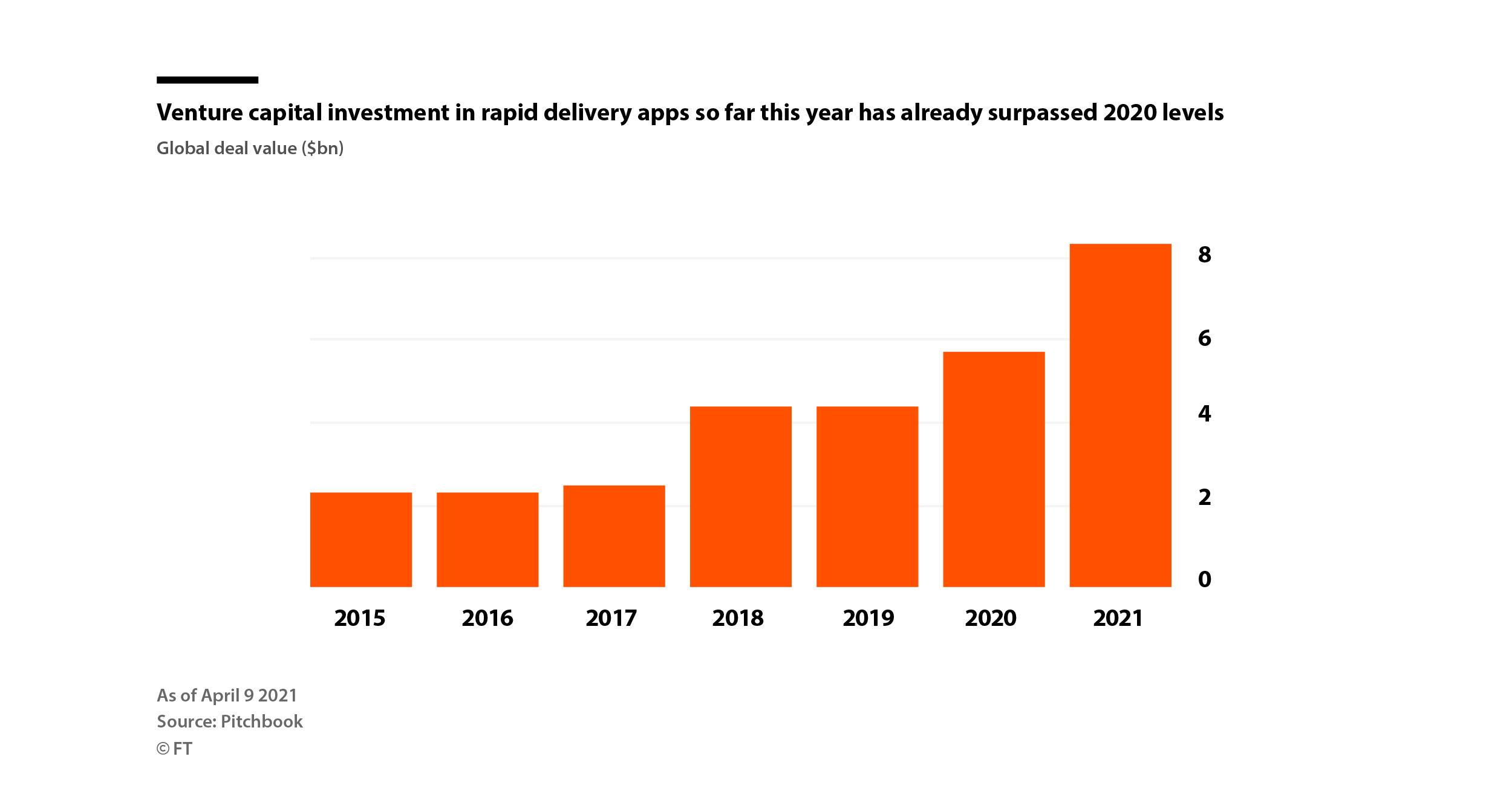
As seen from the chart above, 2020 was the year that instant delivery start-ups gained popularity among investors, and investment in rapid delivery more than doubled only in a couple of years.
Although the pandemic is not at the centre of our lives today, the convenience that came with instant delivery seems like it’s going to stay with us. According to a survey from 2020, 68% of consumers said that they were likely to subscribe to a rapid grocery delivery service even after the pandemic is over.
Major Shift in Customer Expectations
Instant delivery has quickly become one of the new norms of grocery shopping, but giving customers a faster delivery option is not enough. And the biggest topic of instant delivery businesses is now reshaping and enhancing their services considering customer demand.
“Consumers are not going to stick with a company that doesn’t deliver on time, misses the delivery, or doesn’t offer on-demand,” says Alex Osaki, Product Marketing Manager of HERE. And on-demand delivery is not the only thing that customers are looking for.
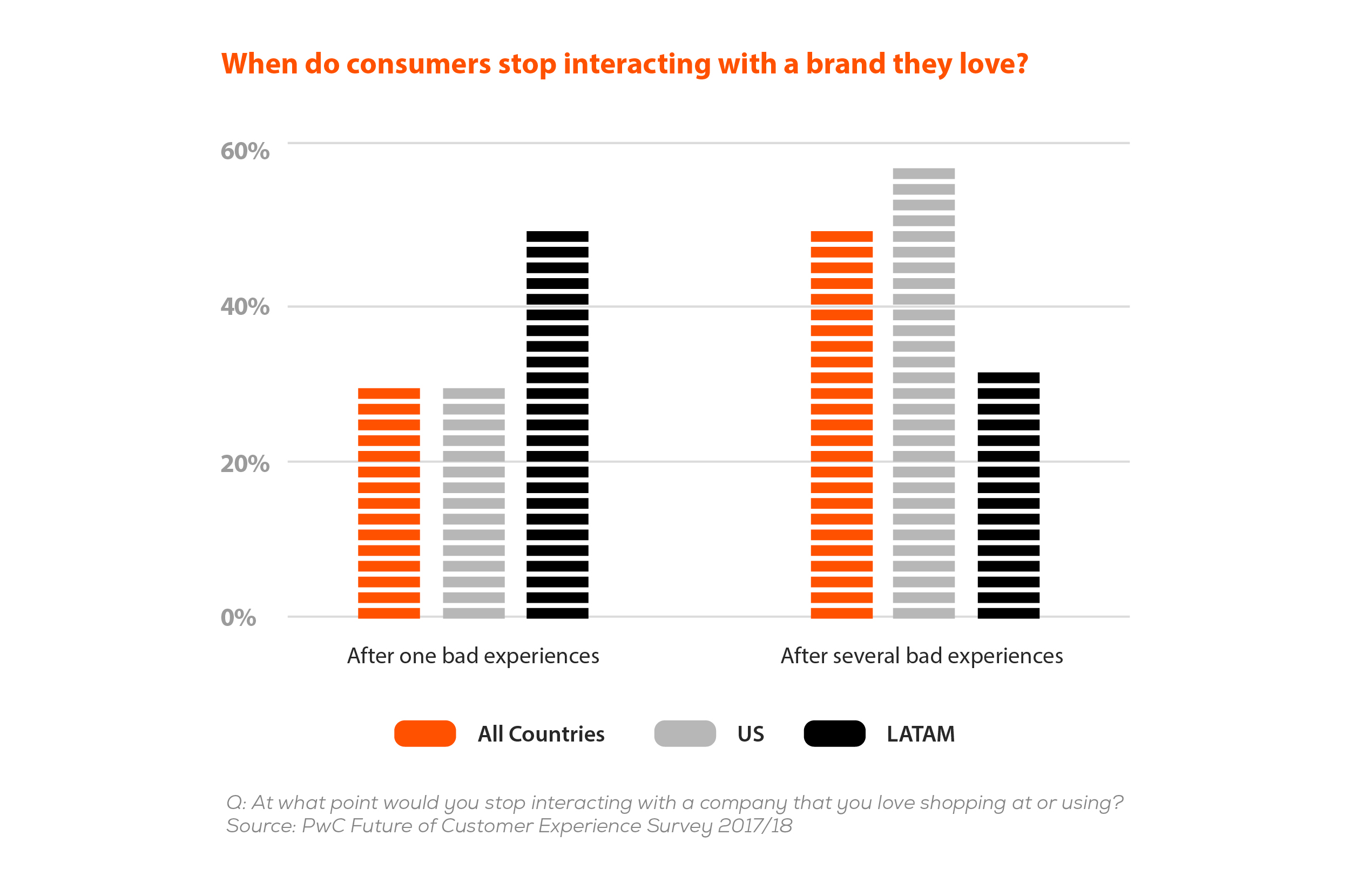
According to PwC’s customer experience report, only one bad experience is enough to end interaction with a brand for nearly 30% of customers. And since instant delivery businesses are usually brands that customers interact with on a regular basis, creating a seamless customer experience is more essential than other business models.
There are three main things that customers demand from an instant delivery service: high speed, functioning customer service, and more personalised deals. The first two may be easy to set up, but when it comes to creating a personalised experience, things may become challenging. Fortunately, SaaS and PaaS companies come to the rescue with evolving, customisable solutions.
Instant Delivery Business Models
The instant delivery business models are different in terms of how they work. They can be mainly classified as third-party delivery platforms or vertically integrated models, which both have their own pros and cons.
Third-Party Delivery Platforms
Third-party delivery platforms are a type of business model that is focused on delivering goods or services to customers. These platforms are usually not the company that provides the service or product; instead, they work with the company to provide this service.
In this model, the platform company is not involved in the transaction between the consumer and the merchant. The platform company only provides a digital marketplace where buyers can browse through different products from different sellers. Merchants offer their products on this marketplace with prices, descriptions, and photos of their products. Consumers can then purchase these products by paying for them using a credit card or with cash on delivery.
Vertically Integrated Models
Vertically integrated models are a type of business model that is used by many companies in the industry. This model requires the company to own and operate all the steps in the supply chain, from production to distribution.
The main idea behind this model is that it allows for faster delivery times and greater control over customer experience. However, there are some downsides to this business model as well. It is much more expensive, and it can be difficult to manage all of these different aspects at once.
The Fastest Growing Instant Delivery Businesses
In less than half a decade, we have seen a massive boom in the instant delivery business model. Today, it’s almost impossible to name the most popular instant delivery businesses. Uber Eats, Getir, Gorillas, Dunzo, Instacart, Amazon Fresh, and Gopuff are the first ones that come to mind when we think about the best instant delivery business models, and they all have their own best features that meet the demands of their region.
Of course, every region is adopting the new trend in grocery shopping differently, but Europe is a good example of the immense growth of rapid delivery services.
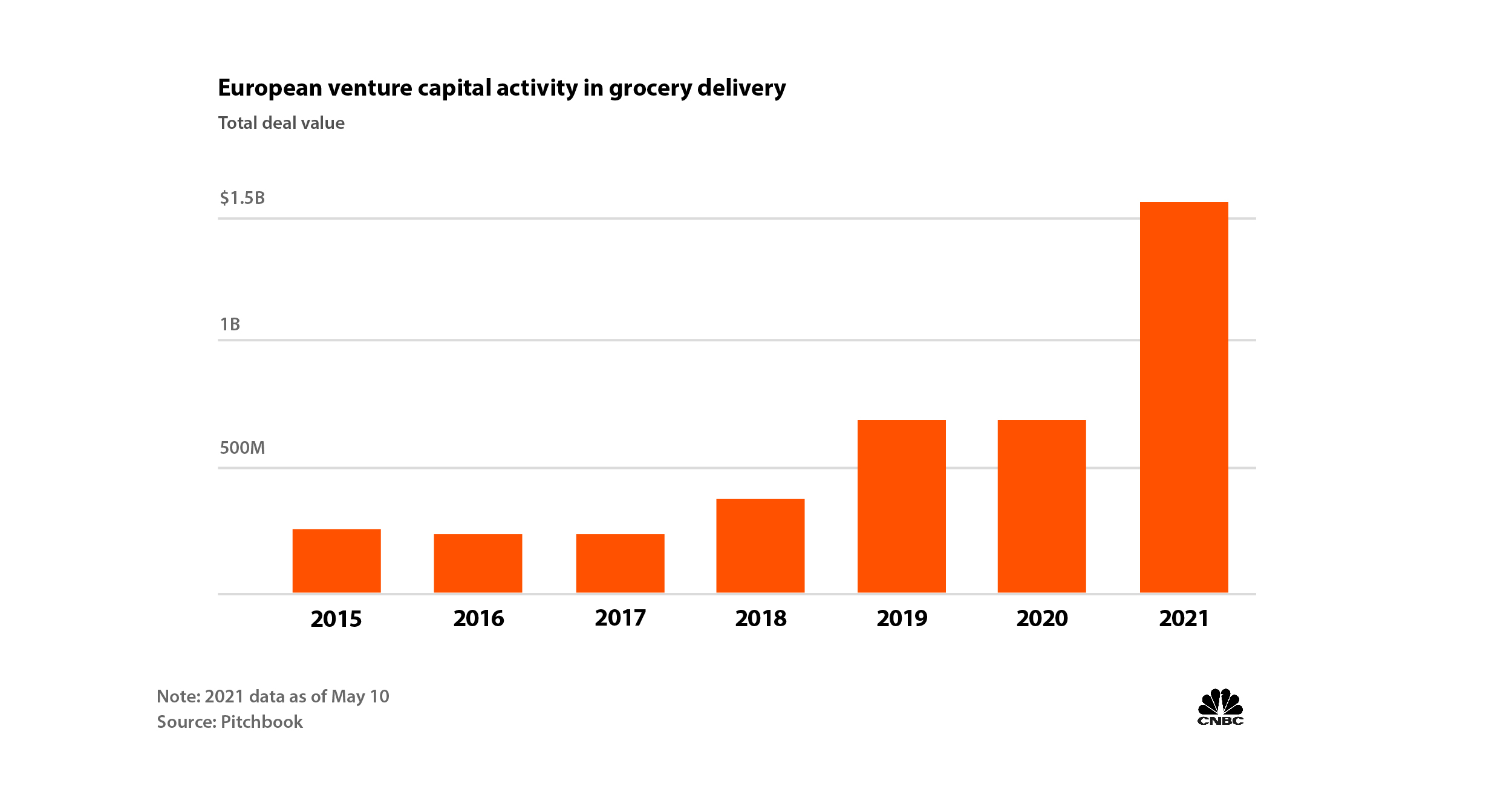
Image source: CNBC
According to data from Pitchbook, last year was the biggest and most impressive year for the growth of instant delivery businesses in Europe. With investment after investment, European instant delivery start-ups like Getir, Gorillas, and Gopuff have kept expanding their operations into new territories, changing the way people shop for instant needs.
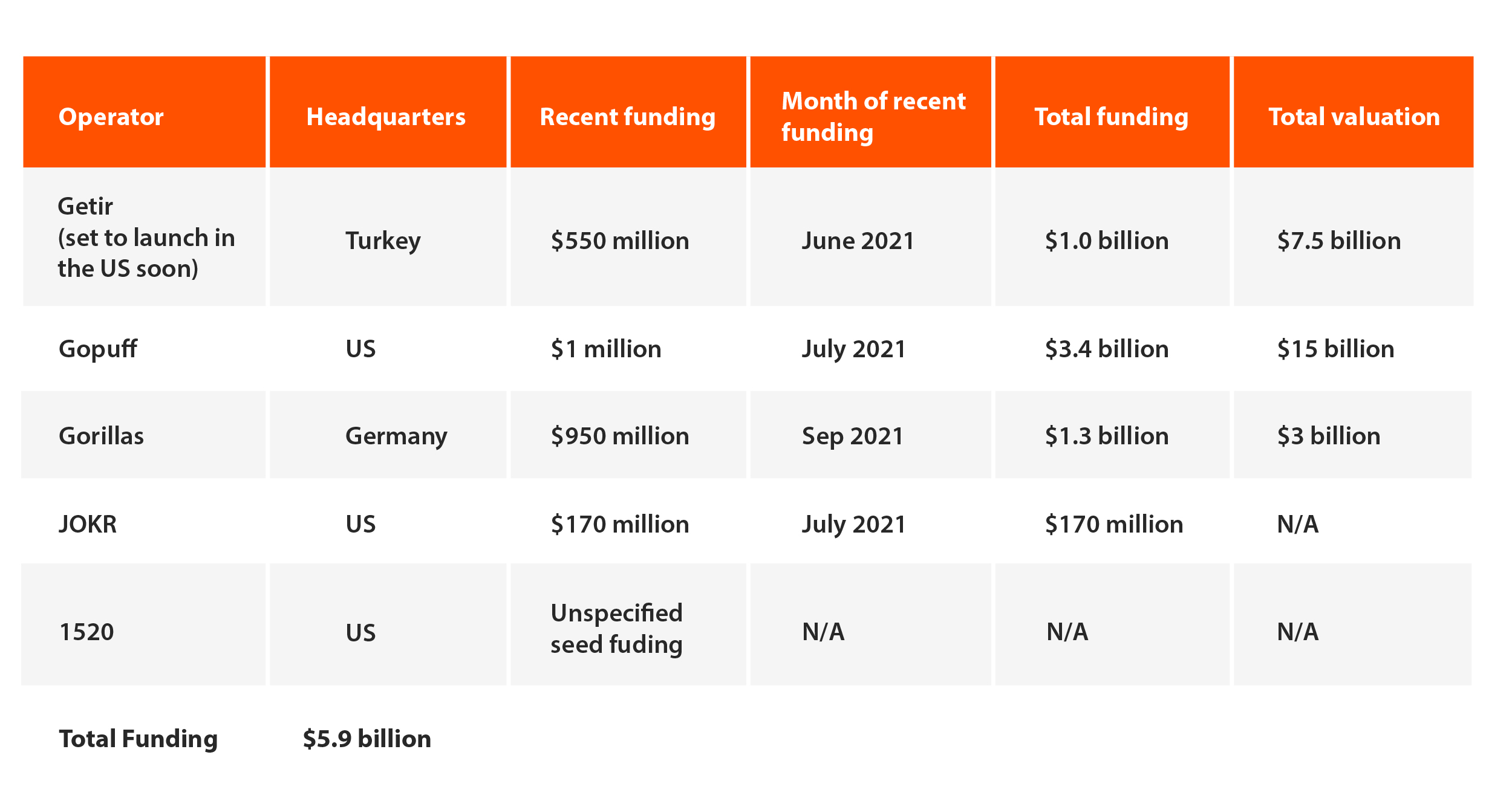
Source: CoreSight
The State of the Biggest Instant Delivery Businesses
Gopuff, the biggest player in the U.S. is getting the biggest share of the investment pie, which was valued at $15 billion last year. Its acquisition of Dija makes the player a considerable player in Europe, too.
One of the biggest instant delivery services in Europe, Getir, has launched in the U.S. in the last quarter of 2021, adding to the 8 European countries in which the Turkish-based delivery startup is active. The company now has more than 1,100 dark stores globally and plans to expand all across Europe.
The German giant, Gorillas, chooses to focus on its base continent, where the competition continues heating up. Last year, the German start-up announced that it paused its U.S. expansion plans for a while to strengthen its operation in 8 European markets.
One of the most senior delivery services in the US, Instacart, stays in safer territory with a longer, 60-minute delivery speed to keep building upon its convenience and plans to expand out of the continent in the following years.
Although start-ups have been the main reason for the rapid grocery transformation in Europe, grocery giants like Walmart are also joining the game as they have no other choice in a world of “new convenience.” Thankfully, it’s not as challenging to set up an instant delivery service as it used to be five years ago. See why it’s essential for groceries to offer rapid delivery on our blog, and keep on reading to see how you can join the game.
Meet Your Instant Delivery Companion: Ubimecs Q-Commerce Platform
After years of rising in eCommerce market share, the industry has taken a new turn quickly with qCommerce. Today, every business, small, medium, or large, is searching for ways to offer under-30-minutes delivery. And setting up a platform that handles the whole operation end-to-end is the first step.
As a SaaS and PaaS powerhouse that’s been working in the e-grocery and e-commerce arena for more than a decade, we saw the shift in the trend toward quick commerce, so we created the Ubimecs Q-Commerce Platform. With our platform, you can have complete control both on the front and back end, and the best part is that it’s fully customisable for the needs of your business.
See how our platform solves the qCommerce challenge on our product page, or request a callback from a Ubimecs expert to discuss further here.

